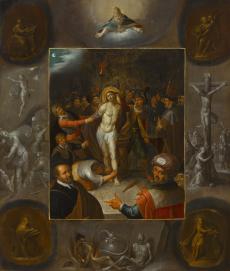


In the centre of this composition, a night-time scene is represented in which Christ is being chained and disrobed amidst a large group of mostly armed people. Two figures in the foreground look outward, while in the middle, on the left, a boy directs the viewer’s gaze towards what is happening to Christ in order to arouse piety and devotion. The man in the lower right corner is recognisable as a Jewish high priest because of his rich clothing and his phylactery, the Jewish prayer band worn around the forehead. According to the Gospel of St John, Chapter 18, this must be Annas or his son-in-law Caiaphas. In the Passion of Christ, the first disrobing took place just before the Flagellation, the second one just before the Crucifixion. Accordingly, this makes it difficult to recognise the precise moment in the story, even if this painting was originally identified as representing a Mocking of Christ.
The event in the centre of the composition is separated by a fine gilt border from the outer scenes, although everything is painted on the same oak panel. On the edges of the central scene, the following were painted in a limited palette of mostly browns and greys: in the four corners, the Four Evangelists; on top, God the Father; on the left, the Resurrection; and on the right, the three Marys at the foot of the cross. At the bottom, there is a scene which is more difficult to interpret, with a serpent around a globe, a skeleton and a satanic figure. The composition originates from Frans Francken II (1581-1642), the most renowned member of a large dynasty of painters. He was trained in the workshop of his eponymous father, Frans the Elder (1542-1616), and his uncle Ambrosius I (c. 1544-1618), together with his brothers Hieronymus II (1578-1623) and Ambrosius II (c. 1590-1632). Because Frans II’s signature is lacking on this work, it can be deduced that it came from his studio: his was one of the most productive in Antwerp, and his large output was only possible because of the cooperation of his brother Ambrosius II and two of his sons, whom he had trained himself, Frans III (1607-1667) and Hieronymus III (1611 – after 1661). More than 500 paintings on copper and wooden panel can be attributed to Frans Francken II and his atelier. These paintings all have so-called cabinet-size dimensions and depict subjects from the Old and New Testaments, mythology, history and allegories. His rare paintings on canvas are mostly large altar pieces, which can be found in churches in several Flemish towns and in Seville.
To create such a large production, the repetition of compositions and motifs played a major role, and in this sense the painting in the A. G. Leventis Collection is no different. We know of at least two other versions of the central scene with Christ, one in the Bayerische Staatsgemäldesammlungen in Munich and one in the Musée d’Art et d’Industrie in Saint-Étienne. Like the work under discussion here, neither has a signature, but, unlike it, both are painted on copper. Ursula Härtung dated the work in Munich to c. 1610-1615; the version in Saint-Étienne is not discussed in her study. We know of about a dozen versions of the scenes on the edges of the painting, on both copper and wooden panel, but always with a different religious scene in the middle. Often this is a Mocking of Christ, for example in the versions in the Musée des Beaux- Arts et d’Archéologie at Besançon and the Museum Catharijneconvent in Utrecht. Both works were recently catalogued, and the scene underneath was identified as, respectively, ‘Les Enfers’ and ‘Mankind after the Fall’. However, a second version of the painting, with both Christ exposed and the same religious scenes surrounding it, is not known, and this makes the painting in the A. G. Leventis Collection stand out among the extensive production of the Francken workshop.
At first glance, it looks as if the painted outer scenes serve as a frame for the central image. Actually, Frans Francken II got the idea from frames painted with scenes as produced at the end of the 16th century in Antwerp by Gillis Mostaert (1528-1598). In addition, Francken must also have been inspired by the religious scenes surrounding a central one that can often be found in late 16th-century Netherlandish devotional prints. Scenes on the outer edges of compositions were produced by Frans II from 1615 onwards and are possibly by the hand of his younger brother, Ambrosius II.
In any case, the outer scenes of an Adoration of the Magi, signed by Frans II and datable to 1615, have been attributed to Ambrosius II. The painting in the A. G. Leventis Collection comes from the studio of Frans II and must be of a later date, probably between 1620 and 1640.
Frans Francken II was the most famous of a large dynasty of painters in Antwerp, where he joined the Guild of Saint Luke in 1605. His studio was one of the most prolific in the city, creating cabinet paintings of scenes from the Old and New Testaments, mythology, history and allegories. Francken also popularised, in Flemish art, genre scenes populated by monkeys enacting human vices and Kunstkamer paintings featuring natural and artistic treasures.